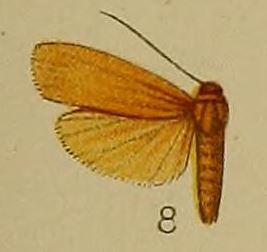
Hippotion velox, the dark striated hawkmoth, is a species of sphingid moth or the family Sphingidae. The species was described by Johan Christian Fabricius in 1793.

Macroglossum corythus is a species of hawk moth of the family Sphingidae. It was described by Francis Walker in 1856 and is found throughout the Indo-Australian tropics east to New Caledonia.

Scopula divisaria is a moth of the family Geometridae. It is found from the Indian subregion, Sri Lanka to Taiwan and Sulawesi.

Eucyclodes gavissima, the Oriental orange banded green geometer moth, is a species of moth of the family Geometridae described by Francis Walker in 1861. It is found in the Indian subregion, Sri Lanka, Bhutan, western China, Taiwan, Vietnam, Sumatra and Borneo.

Scopula junctaria, the simple wave, is a moth of the family Geometridae. The species was first described by Francis Walker in 1861. It is found in the whole of Canada and the northern United States, south to Maryland, Arizona, and California.

Brunia antica is a moth of the family Erebidae described by Francis Walker in 1854. It is found from the Indian subregion, Sri Lanka to China, the Ryukyu Islands, the Chagos Archipelago, the Nicobar Islands and Sundaland.

Comostola pyrrhogona is a moth of the family Geometridae described by Francis Walker in 1866. It is found in the Indo-Australian tropics from India, Sri Lanka to Taiwan, and east to Vanuatu, New Caledonia, northern Australia and Norfolk Island.
Glaucoclystis immixtaria is a moth of the family Geometridae described by Francis Walker in 1862. It is known only from Sri Lanka, the Chagos Archipelago, Queensland and Fiji. It could prove to be more widely distributed, with populations in more seasonally dry habitats such as Java and the Lesser Sunda Islands.

Chasmina candida is a moth of the family Noctuidae described by Francis Walker in 1865. It is found from Indo-Australian tropics east to Fiji, including many islands of the Indian Ocean and Pacific.
Scopula adeptaria is a moth of the family Geometridae. It was described by Francis Walker in 1861. It is found in Sri Lanka, India, Taiwan, Hainan, southern Myanmar, Peninsular Malaysia, Borneo, the Philippines, Sumba and northern Australia.

Scopula attentata is a moth of the family Geometridae. It was described by Francis Walker in 1861. It is found in India, Myanmar and Taiwan.
Scopula cleoraria is a moth of the family Geometridae. It was described by Francis Walker in 1861. It is found in India, Bhutan and Afghanistan.
Scopula emissaria is a moth of the family Geometridae. It was described by Francis Walker in 1861. It is found in India, Sri Lanka, Myanmar, Vietnam, China, Korea, Japan, the Philippines, Sumatra, Java, Wallacea and Australia.
Scopula hyphenophora is a moth of the family Geometridae. It is found in India, Peninsular Malaysia and on Borneo and Bali. The habitat consists of lowland primary and secondary forests, alluvial forests and forests on limestone.

Scopula mecysma is a moth of the family Geometridae first described by Charles Swinhoe in 1894. It is found in the Himalaya, Taiwan, Thailand and on Borneo, Java, Bali, Sulawesi and New Guinea. The habitat consists of lowland forests.
Scopula nesciaria is a moth of the family Geometridae. It was described by Francis Walker in 1861. It is found in Asia including Sri Lanka, China, the Ryukyu Islands, Taiwan and Indonesia.

Scopula opicata is a moth of the family Geometridae first described by Johan Christian Fabricius in 1798. It is found in tropical Africa, including Malawi and Zambia, as well as in Sri Lanka, India, China (Hainan), Myanmar, Sundaland, the Philippines, Sulawesi, Timor and New Guinea.

Scopula pulchellata is a moth of the family Geometridae. It is found in the Indo-Australian tropics, from India, Sri Lanka to Taiwan and the Solomon Islands, as well as in Africa.

Thalassodes immissaria is a moth of the family Geometridae first described by Francis Walker in 1861. It is found in the Oriental tropics of China, India, Myanmar, Sri Lanka, Hong Kong, Japan, Borneo, Vietnam, Sumatra, Sulawesi and the Ryukyu Islands. The populations in Ryukyu were often classified as a subspecies - Thalassodes immissaria intaminataInoue, 1971. However, in 2005 this subspecies was upgraded to a distinct species, which can be distinguished from immissaria by careful examination of the male genitalia.











